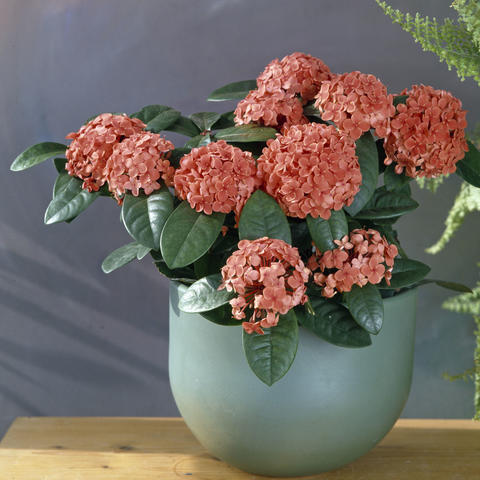Ixora
Ixora coccinea draws all the attention with its colorful flower balls. However, where care is concerned, the exotic flowering plant has several demands.
Factsheet
- Growth type
-
- Small shrub
- Growth height (from)
- from 80 cm to 100 cm
- Growth characteristics
-
- upright
- bushy
- Flower color
-
- yellow
- orange
- red
- Flowering time (month)
-
- April to September
- Flower shape
-
- corymbus grapes
- Flower characteristics
-
- hermaphroditic
- Leaf color
-
- green
- page format
-
- elongated ovate
- Sheet properties
-
- evergreen
- Fruit color
-
- red
- Fruit shape
-
- Stone fruit
- Light
-
- scattered light
- Soil type
-
- sandy to loamy
- Soil Moisture
-
- moderately humid to humid
- ph value
-
- weakly acidic
- Lime compatibility
-
- sensitive to lime
- Nutrient requirements
-
- moderately nutritious
- Humus
-
- rich in humus
- Decorative or utility value
-
- Flower Decoration
- Winter Hardness
-
- frost-sensitive
- Use
-
- Interior greening
- Planters
- Winter garden
- Garden style
-
- Pot garden
Ixora coccinea is a demanding, flowering beauty that originates from the tropical forests of India and Sri Lanka. It belongs to the botanical Rubiaceae family. Without flowers, the evergreen bush is reminiscent of a citrus plant, but during the flowering period in the summer there is no room for confusion: Then Ixora coccinea adorns itself with vibrant, red flower balls. The species is therefore also known as flame of the woods. It is also sometimes referred to as cruz de Malta. In warmer regions, Ixora is often planted as a hedge, in more temperate climates the species and its hybrids are usually cultivated as houseplants.
The evergreen bush, which becomes heavily branched over time, can grow up to 3.29 feet tall. However, the growth rate of Ixora coccinea is more leisurely.
The shiny, green leaves appear elongated ovate, stiff, and leathery.
Ixora coccinea inflorescences are composed of numerous red star-shaped flowers. They are arranged in groups of four, monecious flowers in dense corymbs. The flowering period is from April to September. The flowers of the hybrids can also shine in orange, salmon colors, and yellow.
The spherical stone fruit takes on a red color as soon as it is ripe.

Ixora lives all year round in bright, warm, and humid places without direct sunlight. It likes to be kept in a conservatory or a window box. The ideal soil temperature is 64.4 to 68 degrees Fahrenheit. It reacts very sensitively to sudden temperature changes: The thermometer should not fall below 64.4 degrees Fahrenheit, even in the winter. It is not only the temperature that should not change significantly, the location should also remain relatively consistent: If Ixora is moved too much after budding, the flowers may drop later.
A high-quality, permeable flower soil is a suitable substrate. The pH value should be around 5.5 - i.e. slightly acidic.
Regularly watering and spraying Ixora are some of the most important care measures. The substrate should be kept constantly damp. It can be watered more sparingly in the winter months, however the substrate should never fully dry out. It’s best to use rain water. If nothing but tap water is available, this should be decalcified and brought to room temperature. The ideal air humidity is over 60 percent.
The flowering shrubs are fertilized every two weeks from spring to fall, around April to August. Liquid fertilizer added to the water has proven itself an effective method for pot plants. A fertilizing rhythm of three to four weeks is sufficient in the winter.
Repotting every one to two years is recommended.
Pruning after flowering in the fall promotes branching in Ixora coccinea and its hybrids. Even if the flowering shrubs have become patulous over time, you can get them back in shape with corrective pruning. However, it should not be pruned too often: The flowers only grow on the end of the shoots.

You can place containers with Ixora plants on a water-filled gravel bed to ensure pleasant air humidity.
In addition to the red-flowering species, there are also some other decorative varieties available in trade shops.
- If you are looking for a variety with pink-colored flower balls, ‘Nora Grant’ is a good choice.
- ‘Sunset’ enchants with yellow flowers that are reminiscent of a sunset.
- Flowers of the ‘Super King’ variety are a deep, scarlet red.
Ixora coccinea can be propagated by taking mature head or part cuttings. However, the cuttings only take root at high soil temperatures between 77 and 86 degrees Fahrenheit and in high air humidity. Further cultivation should also not be carried out under 64.4 degrees Fahrenheit.
The Ixora is generally resilient: If the location or care conditions change, it will often drop its flowers and leaves. Where pests are concerned, keep an eye out for scaly insects and spider mites.

